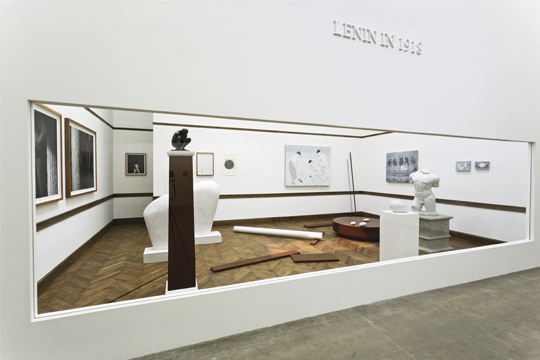YAN XING: RECENT WORKS
| January 20, 2014 | Post In LEAP 24

Courtesy of the artist and
Galerie Urs Meile, Beijing-
Lucerne
Yan Xing’s new solo exhibition “Recent Works” is his most ambitious to date. It consists of four interrelated mixed-media projects: Dirty Art; Lenin in 1918; Two videos, three photographs, several related masterpieces, and American art; and The Collectress. Together these create a consistent atmosphere of quality, repeatedly reminding visitors of the artist’s exquisite control over and design of space, which grants his proclivity for the literary dissimulation of a powerful visual structure. On this occasion, Yan has removed the direct performance of his own “self” from the works, retreating behind the scenes to assume the role of image creator and resource director, his only communicative channel with the outside world being the formal language of the works themselves. Yan works with sensitive materials: sexual metaphors, fabricated realities, and identity politics, meticulously arranging them into a graceful, even rigid aesthetic system in a way that appears logical and justified.
In line with the overall progression of Yan Xing’s exhibitions, both the content and concepts contained within this exhibition are almost entirely visible, while theoretical framework does not replace visual experience. The four works draw on the intellectual spheres of art, history, politics and literature. As no clear distinctions between each are drawn, the precision and rigor with which they are expressed becomes the more important; any detail may become a traceable clue. Dirty Art draws from Edward Hopper’s iconic painting Drug Store, and is made up of nine looped videos which act as a collective footnote to the Chinese character for diarrhea, together forming a metaphorical landscape. In Lenin in 1918, Yan attempts a kind of distillation of the history of Modernism; through re-ordered, reconstructed objects and fabricated documents, he constructs an oblique and apocryphal art-historical anecdote. In Two videos, three photographs, several related masterpieces, and American art, the artist employs violent and sexual symbolism in a series of black-and-white photographs of black men, depicting themes of capture and enslavement. This work is an experiment in multi-layered narrative, and the result of the artist’s countless attempts at combining material and concept, logic and expression. Simultaneously, it is a simulation of, or scoffing reprise of, the notion that America is “the only true point of discussion in contemporary art.”
The Collectress presents the first results of a series on the investigation of images. Yan Xing believes himself something of an expert on the practice of the painter Duan Jianyu, and feels that the two share certain subtle qualities in their creative thinking. In this piece, Yan extracts fictional impressions and stories from Duan’s paintings towards conducting a monochromatic inquiry into urbanization, producing sketches of his impressions from his travels to the New Chinese Countryside. These sketches are then put to use as “evidence” for the material he has abstracted from Duan’s paintings… this equivocal activity, which seems to defy qualitative judgement, is intended as a response to the dialectical relationship that exists between art production and actual systems of logic.
Although it took place outside of the theater, Yan Xing’s “Recent Works” can still be regarded as a rich, multi-layered performance. From the use of black male security guards at the exhibition’s opening to the overly deliberate use of material and labor, the role of narrative is broken down by the interpretive weight of detail, and a sense of ceremony lends the exhibition an aura of classicism. The ability to integrate diverse resources embodied in Yan’s creative tenets and methods is a vital skill for any project-based practice today. An artist’s possession of this ability can even directly determine his rate of growth and breadth of development. In this sense, there is no great disparity in the methods employed to realize “value,” between the art industry and other industries—value being determined by how well the product is accepted, and for how long.

